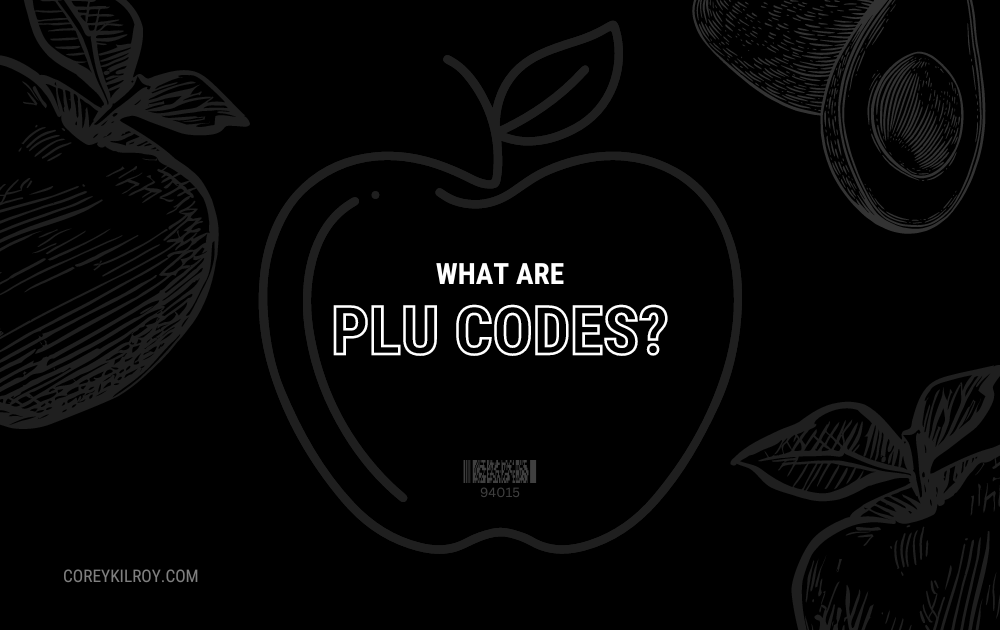You Need to Start Reading the Labels on Your Produce.

If you’ve ever frustratedly flicked off the sticker from your apple, you’re already familiar with the barcodes on all your produce.
They’re called PLU codes.
PLU stands for "Price Look Up" but those stickers are more than just barcodes that your cashier fumbles around searching for.
If you look closely, you'll find four or five digits that can tell you a lot of information about the produce you're about to purchase or consume, most importantly whether it was organically or conventionally grown.
PLU codes can help us learn more about the produce we’re consuming and luckily there are a few hacks to understanding what all of those numbers mean.
Let’s dive a little deeper.
What Are PLU Codes?
PLU codes are a series of numbers that identify the produce sold in retail stores like your local supermarket.
These codes were implemented in 1990 and are regulated by the International Federation of Produce Standards (IFPS).
Some of the digits in PLU codes have the same meaning worldwide, as well as specific codes that apply only to produce grown in the United States.
There are more than 1,400 unique PLU codes that have been assigned to various types of fruits and vegetables.
You can find a PLU code list on the IFPS website and conduct your own PLU code search.
How to Read PLU Codes
Now that you’re familiar with what PLU codes are, you’re probably wanting to learn how to read them, right?
You can get very specific about what every digit in a PLU code means, but there are generally three types of PLU codes that we should be interested in knowing about.
1. Organic Produce
In general, this is any five-digit code starting with the #9.
This produce may also appear as a "9" prefix plus the 3000 or 4000 series number, the IFPS explains.
The 9 is essentially added on to the conventional PLU code. So, for example, the PLU code for conventional large Hass avocados is 4225, while the PLU code is 94225 an organic large Hass avocado, notes California Avocados.
This is the type of produce we should all strive to consume.
For a product to be labeled as “organic” in the United States, farmers and food production companies have to go through a certification process and pass various tests. For example, organic farmers must rotate their crops to keep soil quality high and must only use natural pesticides.
The product itself also has to meet a variety of other regulations set by the United States Department of Agriculture (USDA), such as whether or not artificial preservatives were used, the ability for animals to have access to the outdoors and roam around the produce, and even the type of seeds used to grow the crops.
If a company does want to use the “organic” label on their products, the product must contain at least 95% organic ingredients and can not have any antibiotics, hormones, man-made pesticides, or artificial ingredients.
In short, organic produce is the type we should all be trying to consume, especially if we’re trying to avoid the consumption of toxic pesticides.
2. Conventional Produce
Any four-digit PLU code starting with the #4.
This will tell us that the produce has been conventionally grown.
This means pesticides and/or synthetic fertilizers may have been used by the farmers when growing the produce.
Conventionally grown crops take less space to grow and are said to provide more food per yield than organic.
However, conventionally grown crops are not required to pass strenuous tests for pesticides or growing practices.
There is nothing inherently wrong with conventionally grown produce and they’re even considered safe for humans by the USDA. There’s also little difference found between the nutritional value of organically versus conventionally grown produce.
However, conventional farmers can use pesticides and nitrogen-rich fertilizers with these crops.
This is not only harmful to our health, but it can cause environmental problems, too. Toxic runoff causes algae blooms in nearby streams and lakes, resulting in vast wildlife deaths.
Also, if you’re lifestyle means avoiding toxic pesticides, then I’d try and stay away from this produce, if possible.
3. Genetically Modified Organism (GMO) Produce
Any five-digit code starting with the #8.
This will tell us that the produce is genetically engineered (GE).
You won't see many of these, however, because only genetically modified versions of corn, soybeans, canola, cotton, papaya, and squash are now widely sold.
And because PLU codes aren't mandatory, companies can label those items as conventional.
What are GMOs?
Genetically Modified Organisms (GMOs) are living beings that have had their genetic code changed in some way. Instead of being bred in a garden, GMO seeds are created and bred by biological engineers who apply modern biotechnology techniques (often called “genetic engineering”).
Are GMOs bad for our health?
According to the World Health Organization (WHO), GMOs often bring along 3 main concerns for human health: allergenicity, gene transfer, and outcrossing.
- Allergenicity: Scientists perform tests to make sure these proteins are not allergens. According to the WHO, however, GM foods currently on the market have not been linked with allergic effects.
- Gene transfer: Refers to the possible gene transfer from GM foods to bacteria in the gastrointestinal tract or body cells with the potential to affect human health negatively. This is particularly worrying – though the WHO says the probability of transfer is low – if antibiotic resistance genes, used as markers when creating GMOs, were to be transferred. That’s why leaving antibiotic-resistance genes is discouraged.
- Outcrossing: This happens when the genes from GM plants migrate into conventional crops or wild species (or the other way around). As a result, there may be indirect effects on food safety and food security. According to the WHO, there were reported cases of GM crops approved for animal feed or industrial were found at low levels in products for human consumption. Some countries have adopted policies to minimize this potential mix such as the separation of fields with GM and conventional crops.
So, regarding whether or not GMOs are safe, it depends.
Different organisms include different genes that are transferred using different methods. That’s why the safety of GM foods should be assessed case-by-case.
Up to this date, due to the recency of GM foods and the absence of long-term feeding studies, the safety of genetically modified foods cannot be 100% assured.
What foods are typically Genetically Engineered?
According to the Pew Research Center, in the United States, more than 90% of the
- Soybeans
- Corn
- Cotton, and
- Canola
come from genetically engineered seeds.
Plus, GM ingredients are widely used in processed foods: from corn chips and pizza to cooking oils, baking powder, breakfast cereals, or ice cream.
So my advice: prioritize organic, whole foods in your diet, but don’t beat yourself up for eating GM foods because even insulin and the vaccines we use derived from GMOs.
Future of PLU Codes
Thanks to a growing demand for PLU codes worldwide, the IFPS will run out of available numbers, they explained in a press release in 2015.
That's why in the future they will start to assign PLU codes with an "8" prefix once they run out of available PLU numbers.
On the PLU User Guide on their website, the organization notes that new PLU codes for conventionally grown items will be 83000 to 83999, and new PLU codes for organic produce will receive a number of 84000 to 84999.
And yes, when this happens, it may make it more challenging for consumers to quickly identify whether your choice is conventional or organic at the store.
🏁 In the end…
PLU codes are one of the many systems put in place to help us consumers make informed decisions about what foods we put into their bodies.
While there is little scientific evidence to support any claims that organic produce is healthier for you, I would much rather consume something that hasn’t been contaminated with toxic fertilizers and pesticides.
But that’s just me…
At the very least, being aware of these different PLU codes can help you avoid paying a lot of money for an organic banana when you just want a conventional one to throw at someone during a Mario Kart race.
Good luck and be well.
Until Next Time, C.



